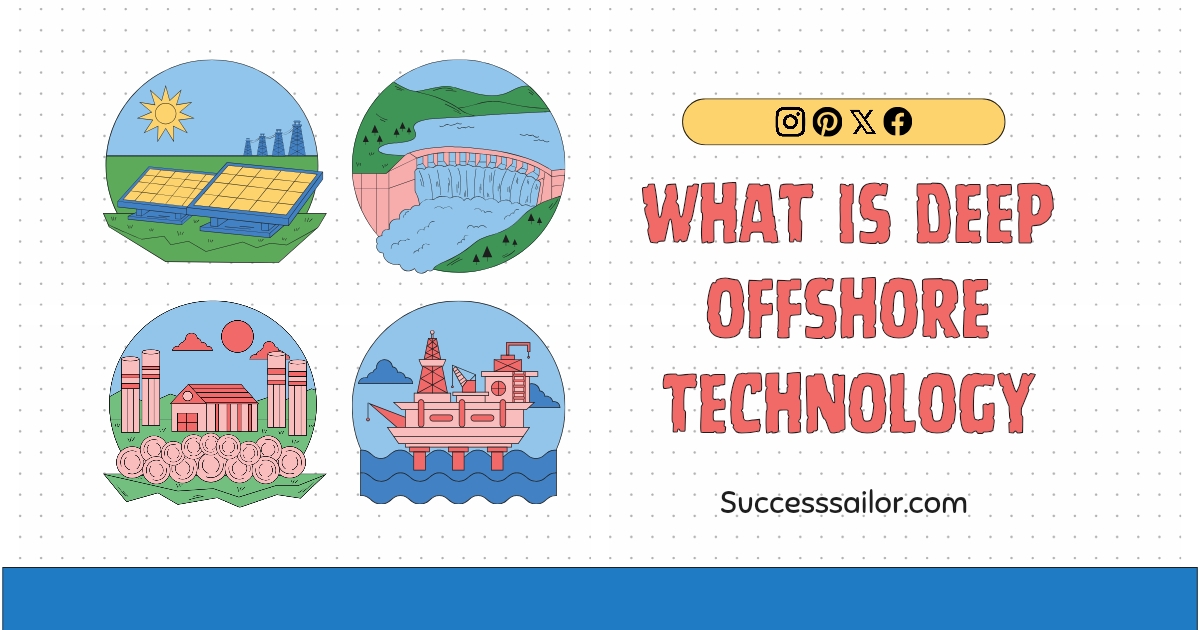Investigate deep offshore technology and its job in removing oil and gas from underneath the seabed. Find out about its set of history, parts, and etc.
Table of Contents
- Presentation
- Verifiable Foundation
- Parts of Deep Offshore Technology
- Kinds of Deep Offshore Stages
- Boring Techniques
- Subsea Frameworks and Hardware
- Headways in ROV and AUV Technologies
- Challenges in Deep Offshore Operations
- Security Measures and Conventions
- Ecological Effect and Management
- Monetary Ramifications
- Contextual analyses
- Future Patterns in Deep Offshore Technology
- The Job of Artificial Intelligence and Large Information
- Conclusion
- FAQs
Presentation
Deep offshore technology alludes to the variety of modern techniques and gear used to investigate, concentrate, and produce oil and gas from underneath the seabed at incredible profundities, frequently surpassing 500 meters. This technology is urgent in satisfying the world’s energy needs as effectively available oil saves decrease. By wandering into deeper waters, energy organizations can take advantage of immense, already inaccessible assets.
Verifiable Foundation
Early Improvements in Offshore Technology
Offshore penetrating started in the late nineteenth 100 years, yet it was only after the mid-twentieth century that critical progressions were made. Beginning offshore operations were restricted to shallow waters, utilizing fixed stages that reached out from the coastline.
Advancement into Deep Offshore Technology
The change to deep offshore technology happened as energy requests expanded and shallow water holds were drained. Developments in drifting stages, penetrating techniques, and subsea gear empowered operations in deeper waters, changing the oil and gas industry.
Parts of Deep Offshore Technology
Subsea Frameworks
Subsea frameworks are essential to deep offshore operations, comprising of hardware introduced on the seabed to control and manage the progression of hydrocarbons.
Drifting Creation Frameworks
Drifting creation frameworks, like FPSOs (Drifting Creation Storage and Offloading units), are utilized to process and store removed oil and gas straight over the wellhead.
Boring Gear
High level penetrating hardware, including progressively situated drillships and semi-sub rigs, considers exact boring in deep water areas.
Kinds of Deep Offshore Stages
Fixed Stages
Fixed stages are moored straightforwardly to the seabed and are utilized in somewhat shallow waters. They give a steady base to boring and creation operations.
Drifting Creation Storage and Offloading
FPSOs are vessels intended to process and store oil and gas. They are especially helpful in deep water where fixed structures are unreasonable.
Fight Stages
Fight stages are huge, tube shaped structures secured to the seabed by securing lines. They are steady and can endure brutal deepwater conditions.
Boring Techniques
Conventional Offshore Boring
Conventional offshore boring includes utilizing fixed stages and shallow water techniques, which are less successful in deep water.
Upgraded Deepwater Boring Techniques
Upgraded techniques incorporate the utilization of cutting edge drillships and powerfully situated rigs, which can operate in deeper waters with more prominent accuracy and security.
Subsea Frameworks and Hardware
Subsea Trees
Subsea trees are introduced on the seabed at the wellhead to control the progression of oil and gas.
Manifolds
Manifolds accumulate oil and gas from different wells, guiding them to a focal handling office.
Subsea Control Frameworks
These frameworks screen and control the progression of hydrocarbons from the seabed to the surface, guaranteeing protected and proficient operations.
Headways in ROV and AUV Technologies
Job of Remotely Operated Vehicles (ROVs)
ROVs are automated, underwater robots used to review, repair, and maintain subsea hardware.
Independent Underwater Vehicles (AUVs)
AUVs operate freely of surface vessels, leading overviews and investigations without direct human control.
Challenges in Deep Offshore Operations
Technical Difficulties
Deep offshore operations require trend setting innovation to endure outrageous tensions and temperatures.
Natural Difficulties
Natural worries incorporate potential oil spills and the effect on marine biological systems.
Financial Difficulties
The significant expense of deep offshore undertakings requires huge venture and financial reasonability.
Security Measures and Conventions
Security Principles in Deep Offshore Boring
Severe security norms are set up to safeguard laborers and the climate during deep offshore operations.
Developments in Security Technologies
Developments incorporate victory preventers and robotized frameworks to screen and control boring operations.
Ecological Effect and Management
Ecological Worries
Deep offshore penetrating postures dangers, for example, oil spills, which can devastatingly affect marine life and waterfront networks.
Moderation Techniques
Alleviation methodologies incorporate thorough ecological appraisals, spill reaction plans, and the utilization of less hurtful boring liquids.
Monetary Ramifications
Cost of Deep Offshore Tasks
Deep offshore tasks are costly, requiring huge interest in technology and foundation.
Financial Advantages and Occupation Creation
Regardless of the significant expenses, these tasks generate significant monetary advantages, including position creation and income for state run administrations.
Contextual analyses
Prominent Deep Offshore Activities Around the world
Tasks, for example, the Inlet of Mexico’s Thunder Pony and Brazil’s Pre-Salt fields have exhibited the potential and difficulties of deep offshore penetrating.
Examples Gained from Past Ventures
Past tasks have featured the significance of security, ecological assurance, and technological development.
Future Patterns in Deep Offshore Technology
Developments Not too far off
Future developments might incorporate high level subsea handling offices, upgraded ROVs, and further developed boring techniques.
Potential Market Development
As technology propels, the market for deep offshore penetrating is supposed to develop, driven by the requirement for new energy sources.
The Job of Artificial Intelligence and Large Information
AI in Prescient Maintenance
AI can foresee hardware failures before they happen, lessening margin time and maintenance costs.
Large Information in Operational Proficiency
Large information investigation advances boring operations, further developing effectiveness and lessening costs.
Conclusion
Deep offshore technology addresses the wilderness of energy investigation, offering admittance to tremendous assets underneath the sea floor. As technology keeps on advancing, the business will confront difficulties and amazing open doors in equivalent measure. By focusing on security, natural insurance, and advancement, the fate of deep offshore technology looks encouraging.
FAQs
What is deep offshore technology?
Deep offshore technology includes the high level techniques and hardware used to investigate and separate oil and gas from underneath the seabed at incredible profundities.
How does deep offshore penetrating contrast from conventional offshore boring?
Deep offshore boring includes operating at more prominent profundities with more modern hardware and techniques contrasted with customary offshore penetrating, which is restricted to shallower waters.
What are the main parts of deep offshore technology?
Key parts incorporate subsea frameworks, drifting creation frameworks, and high level boring hardware.
What natural effects are related with deep offshore penetrating?
Ecological effects incorporate the potential for oil spills and damage to marine biological systems, which require thorough alleviation techniques.
What are what’s in store patterns in deep offshore technology?
Future patterns remember progressions for subsea handling, AI-driven maintenance, and the proceeded with development of the market driven by energy requests.













Leave a Reply